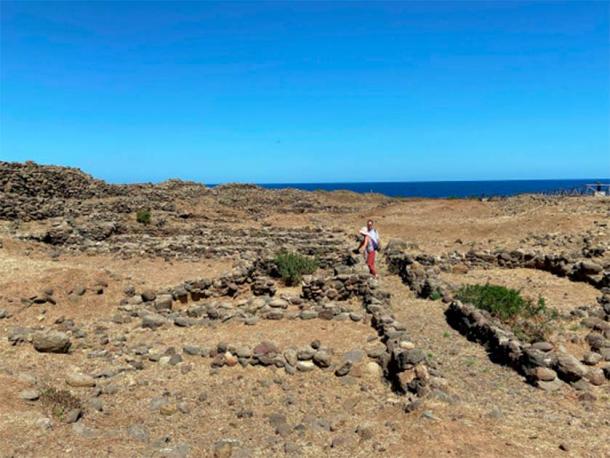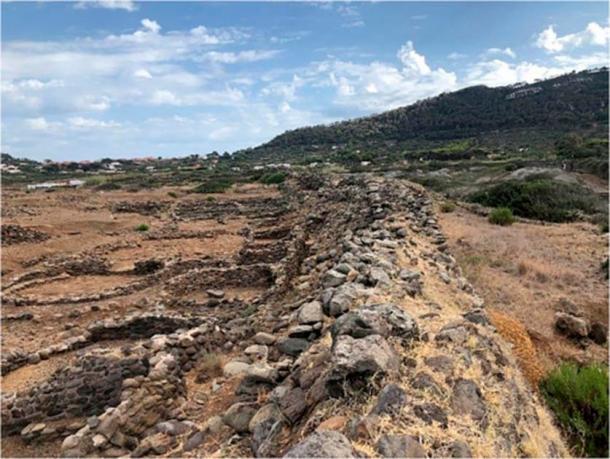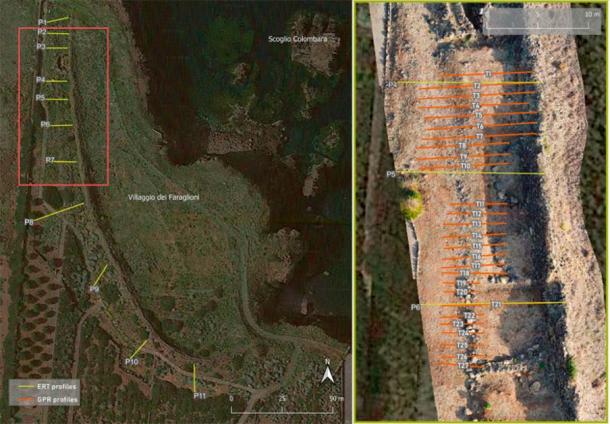Archaeologists studying the ruins of a Middle Bronze Age site on the remote island of Ustica in the Tyrrhenian Sea north of Sicily have uncovered detailed information about the construction techniques and practices used to create the settlement’s elaborate fortification system. Excavations at the location known as Faraglioni Village have been ongoing for five decades, but it took the use of ground-penetrating technologies to finally reveal the interesting new data that sheds light on the monumental building practices of the people who lived on Ustica between during the mid-to-late second millennium BC.
Other studies have proven the utility of subsurface survey techniques when used to explore ancient underground structures, including defensive fortifications. Fortification systems like the one found at Faraglioni Village are often multilayered and complex, as they would have needed to be to provide proper protection for communities that could be besieged by enemies at any time. It turns out this particular fortification system has some highly intriguing and unusual features, as revealed during this groundbreaking new study.
- Hidden Gems of Sicily: The Abandoned Temple Columns of Cave di Cusa
- Pyramids in Sicily: Forgotten Remnants of the Sea Peoples?

The narrow main street (Street I) of “Faraglioni” village and the ruins of prehistoric huts. (Russolillo, A. et al)
Probing More Deeply into Ancient Italy’s Most Heavily Fortified Settlement
Led by researchers from Italy’s National Institute of Geophysics and Volcanology (INGV), a large team of Italian scientists collaborated on a study of what they termed the ‘hidden fortification system at Faraglioni.’ This describes a massive stone wall with supporting stone structures that surrounded the village on its most vulnerable sides, plus underground features that researchers had long known were there, even if they’d never been explored directly.
“The Village of the Faraglioni prospered between 1400 and 1200 BC, in a stretch of coast jutting out into the sea in the northern part of the island,” Domenico Targia, director of Sicily’s Archaeological Park of Himera, Solunto and Iato, explained in an INGV press release.
“Deemed by archaeologists to be one of the best-preserved Mediterranean settlements of its time, it was characterized by an orderly urban plan with dozens of huts built on the edge of narrow streets and by a mighty wall, 250 meters (820 feet) long and between 4 and 5 meters (13 and 16 feet) high, which surrounded the town to defend it from attacks and raids.”
- “Astounding” 1000-year-old Medieval Castle Excavated Stone by Stone in France
- Huge Lost Medieval and Renaissance Castle Complex Discovered in Italy

The enclosing wall of the village of the Faraglioni. (Russolillo, A. et al)
Faraglioni Village’s impressively sophisticated fortification system was built by Middle Bronze Age settlers sometime in the second millennium BC. It includes both above ground and underground structures, and it was the latter in particular that the geophysicists, geologists, archaeologists and architects involved in this research project were most interested in studying.
For the purposes of this research, the Italian scientists relied on non-invasive procedures that can return precise descriptive data about underground structures.
Much to the delight of the scientists, this method of investigation produced excellent and unprecedented results. Extensive underground surveys using ERT (Electrical Resistivity Tomography) and GPR (Ground Penetrating Radar) “allowed us to discover the buried foundations of an outwork fortification system never evidenced by previous archaeological studies, only hypothesized from the observation of aerial photography and partially outcropping boulders, which align roughly parallel to the main defensive wall of the Village,” the study authors wrote in a paper just published in the Journal of Applied Physics.

Left panel) ERT profiles (solid yellow lines). Right panel b) GPR profiles (solid red lines) acquired during the geophysical survey. The red box in the left panel indicates the location of the subset of the area where the GPR profiles were performed. Both acquisition layouts are overlaid on a high-resolution orthographic image of the investigated area (Russolillo et al., 2022). Some profiles of different investigation techniques overlap. (Russolillo et al., 2022).
The outwork fortification system referred to is what is known as an antemural structure. In this context, that describes a defensive stone wall or barrier, rooted deeply in the earth, which is constructed in front of a primary fortification (like the 820-foot stone wall discovered at Faraglioni Village). The purpose of this extra wall is to increase security inside the protected space, and the existence of an antemural structure shadowing the upper-level stone wall at Faraglioni Village shows just how seriously the settlers were about preserving their safety.
Not surprisingly, the Italian scientists were quite pleased with their discovery.
“Our discovery opens a new window on the understanding of this ancient village, suggesting a defensive complexity that goes beyond expectations,” stated Franco Foresta Martin, the director of the INGV-affiliated Earth Science Museum of Ustica. “Geophysical technology allows us to reveal hidden layers of history, paving the way for further investigations without the invasive use of excavations.”
A Tiny Island Filled with Archaeological Marvels
The island of Ustica is truly tiny, covering just three miles (about five kilometers) in width. But during the Bronze Age (1,600 to 1,250 BC), Sicilian settlers from the nearby Aeolian Islands arrived on the island in impressive numbers, and Phoenicians from the eastern Mediterranean region established a presence on the island as well. Maritime commerce thrived in the region in those days, and despite the small size of Ustica, its strategic location made it a natural site for sustained occupation.
As the most prominent ancient settlement on the island, Faraglioni Village “constitutes an exemplary case in the Mediterranean context of the Bronze Age, since it demonstrates that already in those times there must have existed an urban plan with the task of orderly distributing huts and access roads, and designing a long and high defensive wall together with other antemural structures, such as those now discovered thanks to geophysical investigations,” the INGV press release explained.
Faraglioni Village was built on a bluff overlooking the Tyrrhenian Sea, giving it a panoramic view of the surrounding seascape. It enjoyed significant natural protection from high sea cliff walls on one side, but without intervention its landward side would have been easily accessed by invaders who chose to land elsewhere on the island and move in from behind. As a consequence the village settlers constructed a long and massive arched wall that served as the village’s inland border, and it was reinforced with a series of stone buttresses to make sure it remained impenetrable.
Excavations began at Faraglioni Village in earnest in the 1970s, and over the years archaeologists have unearthed an impressive set of ruins there, including the foundations of more than 300 sturdy stone houses built by community residents during the Bronze Age. A wealth of household goods have been recovered as well, including a prodigious collection of 3,000-year-old pottery pieces. Narrow streets ran through the small village at various locations, and the settlers used every bit of the available space to create a complex and fully functioning community where a full range of goods and services could be obtained.
This appears to have been an Aeolian settlement, and it is believed that the Aeolians built the fortification system that protected Faraglioni Village from enemy invasion. But while intensive excavations had revealed many fascinating details about daily life in the Middle Bronze Age village, up to now there had been little research into the fortification system. Much remained unknown about it, including the specifics of its construction and design.
Only so much could be learned from traditional excavations, which is why the researchers involved in the new survey turned to ground-penetrating technologies to reveal the formidable fortification system’s architectural secrets.
“The new discoveries fuel interest in this extraordinary site,” architect Anna Russolillo and archaeologist Pierfrancesco Talamo, two other study participants, explained in the INGV press release. “We now want to deepen our investigations, answering still open questions on the construction and function of the defensive system, and outline a clearer vision of the daily life of this Advanced Age community of the Middle Bronze Age.”